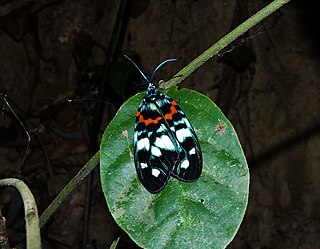
Nippon Budokan, often shortened to simply Budokan, is an indoor arena located in Chiyoda, Tokyo, Japan. Originally built for the inaugural Olympic judo competition in the 1964 Summer Olympics, its name translates as Martial Arts Hall in English. While its primary purpose is to host martial arts contests, the arena has gained additional fame as one of the world's most iconic musical performance venues. Budokan was a popular venue for Japanese professional wrestling for a time, and it has hosted numerous other sporting events such as the 1967 Women's Volleyball World Championship. Most recently, the arena hosted the Olympic debut of karate in the 2020 Summer Olympics as well as the judo competition at both the 2020 Summer Olympics and the 2020 Summer Paralympics.

Nihonbashi (日本橋) is a business district of Chūō, Tokyo, Japan which grew up around the bridge of the same name which has linked two sides of the Nihonbashi River at this site since the 17th century. The first wooden bridge was completed in 1603. The current bridge, designed by Tsumaki Yorinaka and constructed of stone on a steel frame, dates from 1911. The district covers a large area to the north and east of the bridge, reaching Akihabara to the north and the Sumida River to the east. Ōtemachi is to the west and Yaesu and Kyobashi to the south.
Asteropetes is a monotypic moth genus of the family Noctuidae erected by George Hampson in 1901. Its only species, Asteropetes noctuina, was first described by Arthur Gardiner Butler in 1878. It is found on the Kuriles and in Japan.
Koyaga is a genus of moths of the family Noctuidae. The genus was described by Ueda in 1984.
Mosopia is a genus of moths of the family Erebidae. It is found in south-east Asia, including Thailand, Borneo and Malaysia. The genus was first described by Francis Walker in 1866 from a specimen in the British Museum. The specimen Walker describes was from Penang in Malaysia.

Niphonyx is a monotypic moth genus of the family Noctuidae erected by Shigero Sugi in 1982. Its only species, Niphonyx segregata, the hops angleshade, was first described by Arthur Gardiner Butler in 1878. It is endemic to eastern Asia, including the Russian Far East, the Korean Peninsula, Japan, China and Taiwan. It was introduced to the north-eastern United States in the 1990s and is found from Connecticut south to at least Delaware.

Saijō no Meii is a Japanese manga series written by Kenzō Irie and illustrated by Takashi Hashiguchi. It was serialized in Shogakukan's Weekly Shōnen Sunday from December 2007 to February 2010, with its chapters collected in eleven tankōbon volumes. A sequel, titled Saijō no Meii: The King of Neet, was serialized in the same magazine from March 2010 to April 2014, with its chapters collected in nineteen tankōbon volumes.

Orgyia thyellina, the white-spotted tussock moth, is a species of moth of the subfamily Lymantriinae first described by Arthur Gardiner Butler in 1881. It is native to the Russian Far East, Japan, Korea, Taiwan, and China. It was discovered in Auckland, New Zealand, in 1996. Operation Ever Green was established that same year to eradicate the pest. By 1998, the species was eradicated. It is thought of as one of the most successful eradication programmes ever undertaken in an urban area.
Scopula modicaria is a moth of the family Geometridae. It was described by John Henry Leech in 1897. It is found in China, the Russian Far East, Korea and Japan.
Schiffermuelleria imogena is a moth in the family Oecophoridae first described by Arthur Gardiner Butler in 1879. It is found in Japan.

Schistomitra is a moth genus in the family Epicopeiidae described by Arthur Gardiner Butler in 1881. The genus was regarded as a monotypic taxon for a long time, however a second species was newly described in 2019.
Anomis figlina is a moth of the family Erebidae first described by Arthur Gardiner Butler in 1889. It is found in Sri Lanka, India, Australia and Japan.

Blood on the Tracks is a Japanese manga series written and illustrated by Shūzō Oshimi. It has been serialized in Shogakukan's seinen manga magazine Big Comic Superior since February 2017, with its chapters collected into twelve tankōbon volumes as of November 2021. The story follows a middle school student, Seiichi Osabe, and his relationship with his overprotective mother, who after a certain event, begins to show a darker and horrifying side towards her son. The series is licensed for an English release in North America by Vertical, who started releasing the volumes in print in February 2020, and it is also digitally published by Kodansha USA since August of the same year. As of June 2021, Blood on the Tracks had over 1.5 million copies in circulation.

Harem Marriage is a Japanese manga series written and illustrated by NON. It was serialized in Kodansha's Weekly Young Magazine from July 2014 to June 2019, with its chapters collected in nineteen tankōbon volumes. A television drama adaptation premiered in January 2022.

Police in a Pod is a Japanese manga series written and illustrated by Miko Yasu. It has been serialized in Kodansha's Morning since November 2017. It won the 66th Shogakukan Manga Award in the general category in 2021. A Japanese television drama adaptation aired on Nippon TV from July to September 2021, and an anime television series adaptation by Madhouse aired from January to March 2022.

Sweat and Soap is a Japanese manga series written and illustrated by Kintetsu Yamada. It was serialized in Kodansha's digital seinen manga magazine D Morning from June 2018 to August 2019, and later in Morning from October 2019 to January 2021, with its chapters collected in tankōbon volumes. A television drama adaptation premiered on MBS in February 2022.

Wandance is a Japanese manga series written and illustrated by Coffee. It has been serialized in Kodansha's Monthly Afternoon since January 2019, with its chapters collected in six tankōbon volumes as of September 2021. In North America, the manga is licensed for English release by Kodansha USA.

Kanshikan Tsunemori Akane is a Japanese manga series by Hikaru Miyoshi, based on the Psycho-Pass anime series. It was serialized in Shueisha's shōnen manga magazine Jump Square from November 2012 to May 2013, and later on the magazine's official website from June 2013 to December 2014.

Sailor Ace is a Japanese baseball-themed manga series written and illustrated by Shuichi Shigeno. It was serialized in Kodansha's seinen manga magazine Weekly Young Magazine from June 2015 to April 2017.

Erasmia pulchella is a species of moth in the burnet moth family Zygaenidae and in the subfamily Chalcosiinae. It was described by Frederick William Hope in 1840. It is found throughout Southeast Asia, with its range stretching from northern India, Myanmar, Laos, Thailand, Vietnam, China, Taiwan, and Japan. It is the type species of the genus Erasmia.













